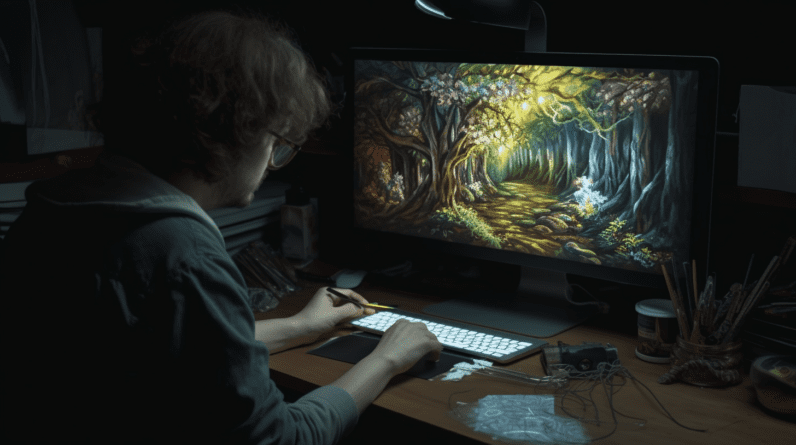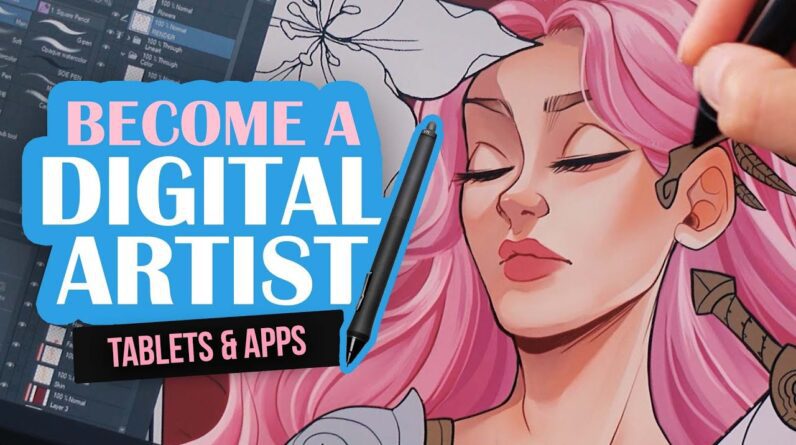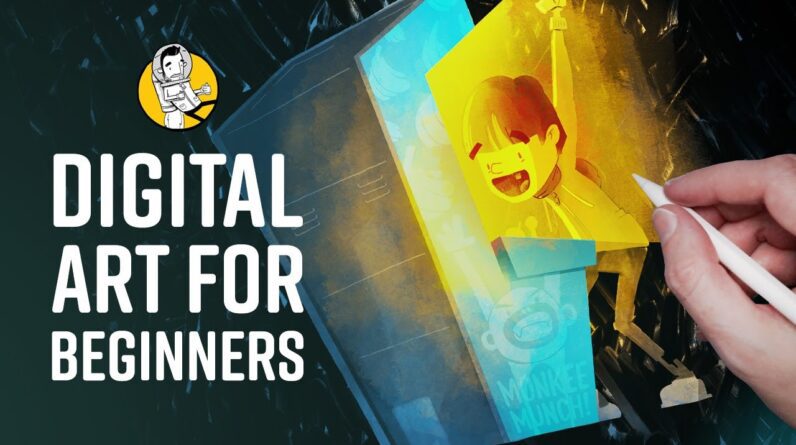
Digital illustration has revolutionized the world of art, providing artists with innovative tools and techniques to unleash their creativity in ways never imagined before. With the advent of advanced software and hardware, artists can now create stunning visuals that captivate and inspire audiences across various industries. In this article, we will delve into the world of digital illustration, exploring its history, benefits, techniques, applications, and career opportunities.
Introduction to Digital Illustration
Digital illustration is the creation of artwork using digital tools such as graphic tablets, styluses, and specialized software. It allows artists to work digitally, eliminating the need for traditional mediums like canvas, paint, and brushes. With the power of technology, artists can manipulate shapes, colors, and textures with precision and ease, resulting in captivating and visually stunning illustrations.
History and Evolution of Digital Illustration
The roots of digital illustration can be traced back to the 1950s when early computer technologies began to emerge. However, it wasn’t until the 1980s that computers became more accessible and software like Adobe Photoshop and Corel Painter were developed, enabling artists to create digital art more effectively. Since then, digital illustration has continued to evolve, with advancements in hardware, software, and techniques, pushing the boundaries of artistic expression.
Benefits and Advantages of Digital Illustration
Digital illustration offers numerous benefits and advantages over traditional methods. Firstly, it provides artists with an extensive range of tools and features, allowing for greater experimentation and flexibility. Artists can easily undo mistakes, adjust colors, and experiment with various brushes and textures, fostering a more iterative and exploratory creative process. Additionally, digital artwork can be easily edited, resized, and shared digitally, making it ideal for collaborations and commercial use.
Tools and Software for Digital Illustration
To create digital illustrations, artists rely on a combination of hardware and software tools. Graphic tablets, such as Wacom Intuos and Huion Kamvas, provide a natural and intuitive drawing experience, allowing artists to translate their movements directly onto the digital canvas. Alongside tablets, digital artists utilize software applications like Adobe Photoshop, Adobe Illustrator, and Procreate, each offering unique features and functionalities tailored to the specific needs of digital illustrators.
Techniques and Styles in Digital Illustration
Digital illustration encompasses a wide range of techniques and styles, catering to various artistic preferences and objectives. From realistic digital paintings to stylized vector illustrations, artists can explore different styles by leveraging the capabilities of digital tools. Techniques such as layering, masking, and blending enable artists to add depth, texture, and effects, while vector-based illustrations allow for scalable artwork without loss of quality.
Tips for Getting Started with Digital Illustration
Getting started with digital illustration may seem daunting, but with the right guidance and practice, anyone can embark on this creative journey. Here are some tips for beginners:
- Invest in a good graphic tablet that suits your needs and budget.
- Familiarize yourself with digital illustration software and its key features.
- Start with simple exercises to practice basic shapes, lines, and shading.
- Explore online tutorials, courses, and communities for guidance and inspiration.
- Experiment with different brushes, textures, and styles to find your unique voice.
Popular Applications of Digital Illustration
Digital illustration finds extensive applications across various industries. Here are some notable areas where digital illustration has made a significant impact:
Digital Illustration in the Advertising Industry
In the advertising world, digital illustrations are widely used to create eye-catching visuals for branding, product packaging, and promotional campaigns. Digital illustrations offer the flexibility to convey complex ideas, emotions, and brand personalities effectively, capturing the attention of target audiences and enhancing brand recognition.
Digital Illustration in the Gaming Industry
The gaming industry heavily relies on digital illustrations to bring characters, environments, and narratives to life. Digital concept art and character design play a crucial role in the game development process, helping developers visualize and refine their ideas before actual production. Illustrators with strong digital skills are in high demand in the gaming industry.
Digital Illustration in the Publishing Industry
Digital illustrations have revolutionized the publishing industry, enabling illustrators to create captivating visuals for books, magazines, and online publications. From children’s books to graphic novels, digital illustrations enhance storytelling, immersing readers in vibrant and imaginative worlds. Additionally, digital publishing platforms offer opportunities for illustrators to self-publish and reach wider audiences.
Digital Illustration in the Film and Animation Industry
Digital illustrations are integral to the production of animated films, TV shows, and visual effects. Illustrators create concept art, storyboards, and character designs, providing a visual blueprint for the production team. With the aid of digital tools, artists can seamlessly integrate hand-drawn and digitally rendered elements, pushing the boundaries of visual storytelling.
Impact of Digital Illustration on Traditional Art
While digital illustration has transformed the creative landscape, it has also had a profound impact on traditional art forms. Traditional artists now have the option to incorporate digital tools into their workflow, allowing for greater experimentation, efficiency, and collaboration. Digital platforms have also facilitated the sharing and promotion of traditional artwork, providing artists with broader exposure and opportunities.
Career Opportunities in Digital Illustration
The rise of digital illustration has opened up exciting career opportunities for aspiring artists. Illustrators can work as freelance artists, collaborating with clients and agencies on various projects. They can also find employment in industries such as advertising, gaming, publishing, and film, where their digital skills are highly valued. Additionally, illustrators can build an online presence through social media platforms and art marketplaces, showcasing their work to a global audience.
Future Trends in Digital Illustration
As technology continues to evolve, digital illustration is poised to push the boundaries of creativity even further. Some emerging trends include:
- Augmented Reality (AR) and Virtual Reality (VR) integration in digital illustration, creating immersive and interactive experiences.
- Artificial Intelligence (AI) tools that assist artists in generating ideas, automating repetitive tasks, and enhancing creative workflows.
- Cross-disciplinary collaborations between illustrators and other creative professionals, resulting in unique and innovative visual narratives.
- Continued advancements in hardware and software, offering more intuitive and realistic digital drawing experiences.
- Increased focus on sustainability and eco-conscious practices in digital illustration, promoting ethical and responsible creative processes.
Conclusion
Digital illustration has revolutionized the way artists create and engage with visual art. Through the power of technology, artists can unlock their creativity, experiment with various styles and techniques, and find exciting career opportunities across industries. Whether you’re an aspiring artist or an admirer of digital art, exploring the world of digital illustration is a gateway to limitless possibilities and boundless imagination.
FAQs
Q1: Is digital illustration limited to professional artists? A1: Not at all! Digital illustration is accessible to anyone with an interest in art. With the right tools and practice, beginners can explore their creativity and develop their skills in digital illustration.
Q2: Can I create digital illustrations without a graphic tablet? A2: While a graphic tablet offers a more natural and precise drawing experience, you can still create digital illustrations using a mouse or touchpad. However, investing in a graphic tablet can greatly enhance your digital art journey.
Q3: Are there free software options for digital illustration? A3: Yes, there are free software options available for digital illustration, such as Krita, GIMP, and Inkscape. These programs offer a range of features and can be a great starting point for beginners.
Q4: Can I sell my digital illustrations online? A4: Absolutely! There are numerous online platforms, such as art marketplaces and print-on-demand services, where you can sell your digital illustrations and reach a global audience.
Q5: How long does it take to become proficient in digital illustration? A5: The time it takes to become proficient in digital illustration varies for each individual. It depends on factors such as your dedication, practice routine, and prior artistic experience. With consistent practice and learning, you can make significant progress in a few months to a couple of years.





